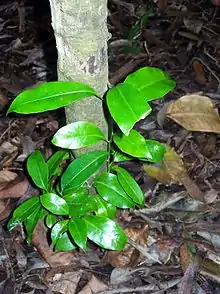Fontainea
Fontainea is a genus constituting part of the plant family Euphorbiaceae.[1][2][3][4] The nine currently known species grow naturally in Queensland (Qld) and New South Wales (NSW) Australia (6 spp.), New Caledonia and Vanuatu (1 sp.), and Papua New Guinea (2 spp.).[2][3][4][5][6] Some species are commonly named blushwood.
| Fontainea | |
|---|---|
 | |
| Fontainea oraria | |
| Scientific classification | |
| Kingdom: | Plantae |
| Clade: | Tracheophytes |
| Clade: | Angiosperms |
| Clade: | Eudicots |
| Clade: | Rosids |
| Order: | Malpighiales |
| Family: | Euphorbiaceae |
| Subfamily: | Crotonoideae |
| Tribe: | Codiaeae |
| Genus: | Fontainea Heckel[1][2][3][4] |
| Type species | |
| Fontainea pancheri | |
One species, Fontainea oraria, the coast fontainea, is known only from 10 living plants growing on private property near Lennox Head in northern New South Wales, Australia. Its status is critically endangered.
In 1870 in a European medical science doctoral thesis Édouard Marie Heckel first named this genus in honour of his supervisor Constant Aristide Fontaine (1818–1900), professor of chemistry and toxicology at Toulon, France.[1][7]
A compound, EBC-46, taken from the seed or other plant parts of these spp. or from Hylandia dockrillii has potential cancer-fighting properties in current research and recently published studies. The experimental drug shows promising early results in pre-clinical trials in animal models.[8][9][10]
Description
Plants in the genus, Fontainea, are shrubs or small trees. They are dioecious or rarely monoecious, and they exude a colored latex. The leaves are alternate, entire and have pinnate venation. The flowers have pedicels. The male flowers have 18 - 32 free stamens on the receptacle, while the female flowers have ovaries with 3 - 6 uni-ovulate cells and 3 - 6 short and deeply bilobed stigmas.[11]
Species
Sourced from the authoritative Australian Plant Name Index and Australian Plant Census,[2] as of October 2014, the 1985 published genus revision,[4] the 1997 new keys and spp. descriptions,[3] and the Kew World Checklist of Selected Plant Families.[6]
- Fontainea australis Jessup & Guymer, southern fontainea – Qld, NSW
- Fontainea borealis P.I.Forst. – Papua New Guinea
- Fontainea fugax P.I.Forst. – Burnett Distr, Qld
- Fontainea oraria Jessup & Guymer, coast fontainea – Lennox Head, NSW
- Fontainea pancheri (Baill.) Heckel – New Caledonia incl Loyalty Is.
- Fontainea picrosperma C.T.White, fountain's blushwood; fontain's blush – Atherton Tableland, Qld
- Fontainea rostrata Jessup & Guymer – Wide Bay–Burnett, Qld
- Fontainea subpapuana P.I.Forst. – Papua New Guinea
- Fontainea venosa Jessup & Guymer – Logan City, Qld
References
- Heckel, Édouard Marie (1870). Etude au point de vue botanique et thérapeutique sur le Fontainea pancheri (nobis). Thèse Inaug. Montpellier. Vol. 9. pp. 10–. Retrieved 12 Oct 2014.
- "Fontainea%". Australian Plant Name Index (APNI), Integrated Botanical Information System (IBIS) database (listing by % wildcard matching of all taxa relevant to Australia). Centre for Plant Biodiversity Research, Australian Government. Retrieved 12 Oct 2014.
- Forster, Paul I. (1997). "Three new species of Fontainea Heckel (Euphorbiaceae) from Australia and Papua New Guinea". Austrobaileya. 5 (1): 29–37. JSTOR 41729915.
- Jessup, Laurie W.; Guymer, Gordon P. (1985). "A revision of Fontainea Heckel (Euphorbiaceae – Cluytiae)". Austrobaileya. 2 (2): 112–125. JSTOR 41738658.
- Forster, Paul I.; Welzen, Peter C. van (1999). "The Malesian species of Choriceras, Fontainea & Petalostigma (Euphorbiaceae)". Blumea. 44: 99–107.
- Kew World Checklist of Selected Plant Families
- Archives nationales (France). Léonore database
- "Frequently Asked Questions". QBiotics. 2014. Retrieved 10 Oct 2014.
- "Scientists discover cancer-fighting berry on tree that only grows in Far North Queensland". Australian Broadcasting Corporation. 8 Oct 2014. Retrieved 8 Oct 2014.
- Boyle, G. M.; d'Souza, M. M. A.; Pierce, C. J.; Adams, R. A.; Cantor, A. S.; Johns, J. P.; Maslovskaya, L.; Gordon, V. A.; Reddell, P. W.; Parsons, P. G. (2014). "Intra-Lesional Injection of the Novel PKC Activator EBC-46 Rapidly Ablates Tumors in Mouse Models". PLOS ONE. 9 (10): e108887. doi:10.1371/journal.pone.0108887. PMC 4182759. PMID 25272271.
- Endemia.nc: Fontainea. Faune et Flore de Nouvelle-Calédonie. Retrieved 25 April 2019.